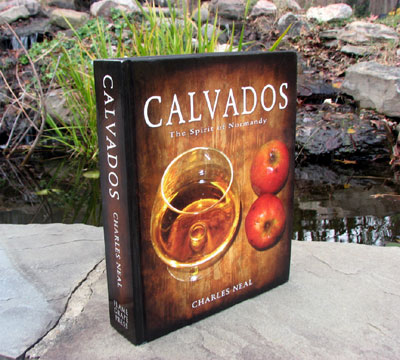Charles Neal, a San Francisco-based writer and wine importer, spent almost a decade researching and writing Armagnac: The Definitive Guide to France’s Premier Brandy. He’s now done it again with Calvados: The Spirit of Normandy, an all-encompassing volume that is the result of another 10-year period of travel, research and writing about the brandy based on the apples and pears of northern France.
The 766-page volume, which weighs more than several bottles of the spirit, is illustrated with photographs, maps and charts as Neal provides geographic, historic, cultural and agricultural background. This includes discussion of D-Day, the life and times of the apple, sketches of authors and artists who came from Normandy and references to regional foods like duck from Rouen, sole de Normandie, boudin de Mortagne, pré-salé lamb, tripes à la mode de Caen and caramels from Isigny. After that, he visits a couple of hundred producers, tasting Calvados, talking to a large collection of French farmers and distillers and filling his car with a variety of bottles of the spirit.
![Bottle_of_Boulard_calvados By Miika Silfverberg from Vantaa, Finland (Calvados (on white) Uploaded by Kubanczyk) [CC-BY-SA-2.0 (www.creativecommons.org/licenses/by-sa/2.0)], via Wikimedia Commons](http://palatepress.com/wp-content/uploads/2012/02/Bottle_of_Boulard_calvados.jpeg)
Neal shows an often-charming, ingenuous attitude as he knocks on doors and engages a variety of farmers, most of them curmudgeons, in discussions that range from apples to cattle, from methods of production to complaints about tax-collectors and bureaucrats. Masses of information surround photographs of fruit, of lovely landscapes and of Calvados producers, most staring straight at the camera and holding a glass of spirits. His descriptions of Normandy are reminiscent of tales of Sonoma County, where practically everything grows and can be harvested to create delicious food and drink.
Information and stories galore
The book constantly offers a remarkable amount of detail. For instance, we learn that the INAO (Institut National des Appellations d’Origine) recognizes 354 varieties of apples that grow in Normandy, in several different categories: Sweet like the Binet Rouge or Clos Renaux; Bitter-Sweet like Douce Moen; Bitter like Frequin Rouge; and Acidic like Locard Vert or Petit Jaune. Neal also discusses some 50 different pear varieties.
The first step from apples to Calvados is cider, and because of the yeast on the skins and the sugar in the pulp, apple juice begins its journey to cider within days of harvest, unless the juice is chilled. After the cider stage is reached, there still is time to decide if the resulting product will remain as cider or go through the distillation process, on the way to becoming Calvados.
![Map_aoccalvados Henrik mattson [CC-BY-SA-2.5 (www.creativecommons.org/licenses/by-sa/2.5)], via Wikimedia Commons](http://palatepress.com/wp-content/uploads/2012/02/Map_aoccalvados-300x223.jpg)
In his travels throughout Normandy, Neal visits farmers and distillers of all types, like Philippe Lebosse at the Domaine de la Roselière, in the tiny hamlet of St.-Cyr-de-Bailleul, who refused to offer a sample, or the unidentified man in the same town who offered juice, then Calvados. Neal, who thought the brandy “awesome,” said he didn’t want a full bottle, so the man rinsed an empty wine bottle, poured some Calvados from a carafe and took Neal’s money. As the author mused, “There seemed little difference between this old guy and one’s drug connection.”
Neal has lots of stories like this to tell, along with more information about Calvados and its home territory than one can shake the proverbial stick at. A delightful volume for reading in bites, as if one is enjoying a buffet of words about a splendid drink.
Calvados, The Spirit of Normandy, by Charles Neal. Flame Grape Press, San Francisco. 766 pages plus photographs, maps and index. $60.00 (Distributed by the Wine Appreciation Guild, 360 Swift Ave., #34, San Francisco, Calif., 94080).
Joe Pollack has been writing and talking about sports, wine, food, entertainment and other happy subjects for more than 50 years for newspapers, radio and TV stations, magazines, newsletters, blogs and other means of disseminating words and opinions. He has children and grandchildren scattered throughout the world and a wife, Ann Lemons, who is a good writer and an even better cook. He writes at St Louis Eats.
